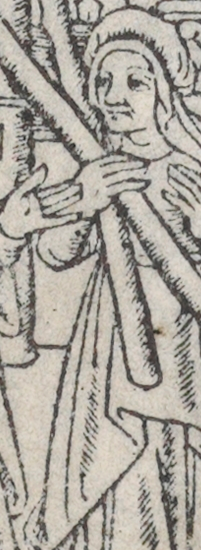Re-attribution of folio from a fifteenth (?) century Book of Hours, previously listed as printed for Simon Vostre in 1488
Anna Majeski
Based on stylistic comparison with a Book of Hours currently found in Harvard’s Speical Collections at Houghton Library, I would reverse the attribution of the above folio, instead attributing it to Thielman Kerver. Kerver was a Parisian publisher active in Paris from 1497 to 1522, as such the present date for the folio—1488—must also be reevaluated.
The Houghton Library Book of Hours, although not the same edition as the folio in the Tisch collection, reproduces the same typographical borders found in the Tisch folio. The description of the borders as found in the Tisch example is as such:
On the recto of the Tisch folio, the border frames the texts “Libera me” and the beginning of Psalm 50. The lateral border depicts three images, interspersed with two lines of text. At the top, Jezebel sending a messenger to Elijah (1 Kings 19:2); at center Christ before Pontius Pilate, Pilate washing his hands (Matthew 27: 24-25); at bottom, King Nebuchadnezzar, forced to give Daniel to the furious populace (Daniel 14:29). The citation which corresponds to the New Testament image is divided between two rectangles in the lateral border, it reads: “Accepta aq la uit man’ cora populo dices. Innoces ego sum a sangui-ne.Mat.27”.
The foot-piece depicts: two Old Testament prophets, between which are found the two citations corresponding to the Old Testament images from the lateral border. The topmost citation is from 1 Kings 19:2 and reads, “Misitque iesabel nu- tiu ad helia dices hec mi.rc.m. reg.19.” The bottommost citation is from Daniel 14:29, “Topuls’ nabucho-donosor tradidit eis daniele.Da.14”. The headpiece depicts a grotesque holding a sword hunting a quadruped, with floral decoration; the inner border depicts a hunter with two dogs at the bottom, a man playing the bagpipes in the middle, and a grotesque at the top amid floral decoration.
The verso of the Tisch folio continues Psalm 50, and starts Psalm 64. Its border uses the same set-up. The lateral border depicts: at top, Abraham and Isaac, Isaac carrying a bundle of wood (Genesis 22:6); at center: Jesus carrying the cross (John 19:17); at bottom, Elijah and the Widow of Zarephath (1 Kings 17:12). The text which corresponds to the New Testament image, found in the lateral border reads, “Et baiulans sibi crucem exivit i eum q dicit Calvariae locu hebraice Golgotha.Jo.19”.
The foot-piece depicts: two Old Testament prophets, between which are found the two citations corresponding to the Old Testament images in the lateral border. The topmost citation is from Genesis 22:6, “Tulit quoqm ligna olocausn:et iposuit iup ysaac.Gen.22”. The bottommost citation is from 3 Kings 17:12, “En colligo duo ligna ut ingrediar: et facia illud.3.re.17”. The headpiece depicts a centaur shooting a bow and arrow at a quadruped amid floral decoration. The inner border depicts, at the bottom, a grotesque, at center, a monk indicating the text with his finger, and at the top, a man riding an animal, amid floral decoration.
There are 26 long lines to a page, printed in roman type with hand-illuminated initials, gold with a background of blue or red. Quotations in the borders are printed in red gothic script.
The lateral pieces found in the Tisch folio are reproduced in the Houghton Hours twice, once in the Hours of the Virgin, and once in the Hours of the Conception of the Virgin Mary. In the first instance, the recto of our folio is found on the verso of one page, the verso found on the recto of the next page; in the second instance, they are printed following the same recto/verso format. The citations found in the Tisch folio, as they enumerate the imagery found in the borders and are therefore tied to these images, are reproduced in the same manner in the Houghton example. The headpieces and foot-pieces of the Tisch folio are also found reproduced in the example from Houghton, however they are not printed on the same page.
The Houghton example also has 26 long lines to a page, is printed in roman type with the same manner of hand-illuminated initials, and the quotations in the borders are printed in red gothic script.
As far as the advancement of a specific edition for the Tisch folio, more research is required. However the Houghton Catalogue states that the borders used in the 1505 edition were also used by Kerver in an Officium of 1500, so they had to be created at some point between 1497 (the date Kerver became active) and 1500. We can further limit the date of the Tisch folio to before 1517, as at this point Kerver largely re-cuts the borders depicting the Life of Christ with Old Testament parallels.
Notes:
1. TYP 515.05.262. Ref: Mortimer, Ruth. Harvard College Library Department of Printing and Graphic Arts, Catalogue of Books and Manuscripts; Part I: French 16th Century Books. Cambridge, Massachusetts: Belknap Press of Harvard University (1964). Cat no. 294.
2. In Daniel 14, the King is actually Cyrus and not Nebuchadnezzar, however in the footpiece of the Tisch folio the king is cited as Nebuchadnezzar (Nabuchodonosor). This same error is made in the Esztergom Blockbook of Forty Leaves, a Biblia Pauperum from the fifteenth century. See: Avril Henry, ed.. Biblia Pauperum: A Facsimile and Edition. Ithaca, New York: Cornell University Press (1987). Pg 140, note b. 13.
3. Abbreviations used by the scribe have not been included in the citation, reference the images provided on website.
4. Mortimer, ibid. pg 379.
5. Ibid., pg. 389.

